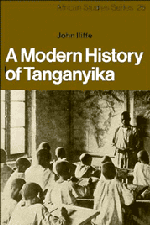Book contents
- Frontmatter
- Contents
- List of maps and tables
- Preface
- Acknowledgments
- Terminology
- Abbreviations
- Map I Tanganyika
- 1 Intentions
- 2 Tanganyika in 1800
- 3 The nineteenth century
- 4 The German conquest
- 5 Colonial economy and ecological crisis, 1890–1914
- 6 The Maji Maji rebellion, 1905–7
- 7 Religious and cultural change before 1914
- 8 Fortunes of war
- 9 The origins of rural capitalism
- 10 The creation of tribes
- 11 The crisis of colonial society, 1929–45
- 12 Townsmen and workers
- 13 The African Association, 1929–48
- 14 The new colonialism
- 15 The new politics, 1945–55
- 16 The nationalist victory, 1955–61
- Bibliography
- Index
- Frontmatter
- Contents
- List of maps and tables
- Preface
- Acknowledgments
- Terminology
- Abbreviations
- Map I Tanganyika
- 1 Intentions
- 2 Tanganyika in 1800
- 3 The nineteenth century
- 4 The German conquest
- 5 Colonial economy and ecological crisis, 1890–1914
- 6 The Maji Maji rebellion, 1905–7
- 7 Religious and cultural change before 1914
- 8 Fortunes of war
- 9 The origins of rural capitalism
- 10 The creation of tribes
- 11 The crisis of colonial society, 1929–45
- 12 Townsmen and workers
- 13 The African Association, 1929–48
- 14 The new colonialism
- 15 The new politics, 1945–55
- 16 The nationalist victory, 1955–61
- Bibliography
- Index
Summary
During the nineteenth century Tanganyika's inland peoples made contact with the outside world through a long-distance trading system based on Zanzibar, which became a satellite of Europe's growing power in the Indian Ocean. Tanganyika experienced a transformation more intense than any other region of tropical Africa at that time. It is the essential background to the colonial period. Yet the transformation was not a straightforward replacement of old by new. Men and societies experienced enlargement of scale most unevenly. Some participated enthusiastically in the new trading system while others resisted it. Some created new political systems while others defended their old polities or saw them shattered by change. Some adopted elements of the coastal culture while others reformulated inherited ideas and customs. These reactions formed a spectrum comparable to the later spectrum of responses to colonial rule. And they affected relationships between men and nature. More detailed and reliable traditions and the first European travellers' accounts make the period less obscure than earlier centuries. This chapter describes the long-distance trading system and examines its political, economic, cultural, and religious impact.
The growth of long-distance trade
In 1776 the trade route leading south-westwards from Kilwa to the dense populations around Lake Nyasa was the only route inland from the Tanganyikan coast. It was pioneered in the sixteenth century when the Portuguese seized the gold trade and forced Kilwa's merchants to trade with their own hinterland.
- Type
- Chapter
- Information
- A Modern History of Tanganyika , pp. 40 - 87Publisher: Cambridge University PressPrint publication year: 1979



